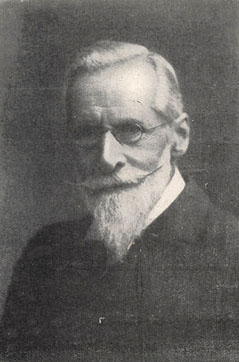| Sir William Crookes  AKA William Crookes AKA William Crookes
Born: 17-Jun-1832
Birthplace: London, England
Died: 4-Apr-1919
Location of death: London, England
Cause of death: unspecified
Gender: Male
Race or Ethnicity: White
Sexual orientation: Straight
Occupation: Chemist, Physicist Nationality: England
Executive summary: Discovered element Thallium English chemist and physicist, born in London on the 17th of June 1832, and studied chemistry at the Royal College of Chemistry under August Wilhelm von Hofmann, whose assistant he became in 1851. Three years later he was appointed an assistant in the meteorological department of the Radcliffe observatory, Oxford, and in 1855 he obtained a chemical post at Chester.
In 1861, while conducting a spectroscopic examination of the residue left in the manufacture of sulphuric acid, he observed a bright green line which had not been noticed previously, and by following up the indication thus given he succeeded in isolating a new element, thallium, a specimen of which was shown in public for the first time at the exhibition of 1862. During the next eight years he carried out a minute investigation of this metal and its properties. While determining its atomic weight, he thought it desirable, for the sake of accuracy, to weigh it in a vacuum, and even in these circumstances he found that the balance behaved in an anomalous manner, the metal appearing to be heavier when cold than when hot. This phenomenon he explained as a "repulsion from radiation", and he expressed his discovery in the statement that in a vessel exhausted of air a body tends to move away from another body hotter than itself. Utilizing this principle he constructed the radiometer, which he was at first disposed to regard as a machine that directly transformed light into motion, but which was afterwards perceived to depend on thermal action.
From there he was led to his famous researches on the phenomena produced by the discharge of electricity through highly exhausted tubes (sometimes known as "Crookes' tubes" in consequence), and to the development of his theory of "radiant matter" or matter in a "fourth state", which led up to the modern electronic theory. In 1883 he began an inquiry into the nature and constitution of the rare earths. By repeated fractionations he was able to divide yttrium into distinct portions which gave different spectra when exposed in a high vacuum to the spark from an induction coil. This result he considered to be due, not to any removal of impurities, but to an actual splitting-up of the yttrium molecule into its constituents, and he ventured to draw the provisional conclusion that the so-called simple bodies are in reality compound molecules, at the same time suggesting that all the elements have been produced by a process of evolution from one primordial stuff or "protyle."
A later result of this method of investigation was the discovery of a new member of the rare earths, monium or victorium, the spectrum of which is characterized by an isolated group of lines, only to be detected photographically, high up in the ultra-violet; the existence of this body was announced in his presidential address to the British Association at Bristol in 1898. In the same address he called attention to the conditions of the world's food supply, urging that with the low yield at present realized per acre the supply of wheat would within a comparatively short time cease to be equal to the demand caused by increasing population, and that since nitrogenous manures are essential for an increase in the yield, the hope of averting starvation, as regards those races for whom wheat is a staple food, depended on the ability of the chemist to find an artificial method for fixing the nitrogen of the air.
An authority on precious stones, and especially the diamond, he succeeded in artificially making some minute specimens of the latter gem; and on the discovery of radium he was one of the first to take up the study of its properties, in particular inventing the spinthariscope, an instrument in which the effects of a trace of radium salt are manifested by the phosphorescence produced on a zinc sulphide screen. In addition to many other researches besides those here mentioned, he wrote or edited various books on chemistry and chemical technology, including Select Methods of Chemical Analysis, which went through a number of editions; and he also gave a certain amount of time to the investigation of psychic phenomena, endeavoring to effect some measure of correlation between them and ordinary physical laws. He was knighted in 1897, and received the Royal (1875), Davy (1888), and Copley (1904) medals of the Royal Society, besides filling the offices of president of the Chemical Society and of the Institution of Electrical Engineers. He married Ellen, daughter of W. Humphrey, of Darlington, and their golden wedding was celebrated in 1906.
Wife: Ellen Humphrey
University: Imperial College London
Royal Medal 1875
Davy Medal 1888
Copley Medal 1904
Knighthood 1897
Royal Society President (1913-15)
Institution of Engineering and Technology
Requires Flash 7+ and Javascript.
Do you know something we don't?
Submit a correction or make a comment about this profile
Copyright ©2019 Soylent Communications
|